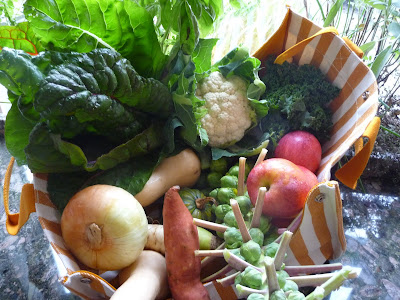
Fall is coming, with its cortege of amber colors and burnt wood smells. Under the mild climate of the eastern shore the days are often sunny but there is crispness in the air, which signals a change of season. My vegetable garden is still going strong and the green beans, beets, leeks, carrots, cardoons, kales, broccolis, cauliflower, cabbages and Brussels sprouts pile up on my kitchen table. In fact vegetables and salads are at their best in slightly colder weather. I am inspired by this fresh display to eat mainly vegetarian. As I have replanted the herbs inside, I have plenty of aromatics to play with. The following recipes, as often in a working kitchen are variations on themes already visited. Blinis, béchamel and my fondness for Moroccan savors and French cuisine are familiar by now. The vegetables showcased in the recipes are not the only ones, which can benefit from the techniques described: any large leaf plants can be substituted for cardoon or Swiss chard, for example salad or cabbage. A Greek version of the Syrian stuffed cardoon even uses grape leaves albeit marinated. Leaves are not all similar however and a tough plant such as kale needs a longer cooking time to become palatable. Béchamel and cheese will transform most vegetables into a gratin: instead of cauliflower, broccoli, endive, cabbage and even cucumber will do. When marketing, it is more important to select the freshest product than to buy the precise ingredients the recipes call for.
All recipes serve 4, except for the first. Suggested quantities will provide about 30 blinis.
Green blinis
(Easy, Preparation and cooking time: 30 minutes, Cheap)
Ingredients:
Bouquet of cardoon leaves
Bouquet of parsley
1 onion
2 garlic cloves
4 cups flour
3 cups milk
3 eggs
Salt and pepper to taste
½ cup cooking oil
Material
Food processor with the blade attachment on
Blender
Salad bowl
Frying-pan
Wash and dry the cardoon leaves and the parsley. Mince in the food processor. Peel the onion and garlic. Add to the content of the food processor and mince finely. Reserve in a salad bowl.
Place the eggs, milk and flour in the blender and mix well.
Pour into the salad bowl and mix everything.
Pour the oil in the frying pan and place on the medium range of the gas. When the oil is hot, pour 4 times ¼ cup worth of batter. Make sure each mound is kept separate. When the batter bubbles, flip the pancake over. Repeat until you run out of batter
Serve hot with a salad.
Moroccan beets
(Easy, Preparation and cooking time: 40 minutes, Cheap)
Ingredients:
4 cups beets
1 tablespoon cinnamon powder
1 tablespoon cumin powder
1 teaspoon mild pepper (from Espelette) powder
2 tablespoons sugar
4 tablespoon orange water
The juice of a lemon
Material:
1 4-quart saucepan
Salad bowl
Remove and discard the leaves of the beets and wash the roots carefully.
Place them in the saucepan. Cover them with water and set the saucepan over low gas. Cook 20 to 30 minutes after the water boils. The beets are cooked when they can be easily pierced with a knife. Keep ½ cup of the cooking liquid. Strain and peel the beets.
Slice the beets. Place them in the salad bowl. Sprinkle them with the cinnamon, cumin, mild pepper and sugar. Pour the ½ cup reserved cooking liquid, the orange water and lemon juice on top and mix well.
Syrian stuffed cardoons
(Easy, Prepartion and cooking time: 1 hour, Cheap)
Ingredients:
16 leaves of Swiss chard
3 lemons
4 tablespoons of olive oil
Stuffing:
1-cup ½ Arborio rice
1 cup chickpeas
2 bouquets parsley
1 bouquet mint
2 onions
½ cup olive oil
1 teaspoon cinnamon
Salt and pepper
Material:
1 food processor, blade attachment on
1 saucepan and cover
1 salad bowl
Paper towels
Set of tongues
For the stuffing, clean and strain the rice and place in a salad bowl. Clean and dry all the herbs and mince them in the food processor. Add the peeled onions and mince again. Add the rinsed and drained chickpeas, the oil, salt, pepper and cinnamon. Mix well.
Separate the leaves from the ribs of the cardoons.
Fill the saucepan with water. Bring to a boil and plunge the cardoon leaves in the water one at a time for 3 minutes. Retrieve from the water and drain on paper towels.
Layer the ribs at the bottom of the saucepan.
Roll each leaf around a cylinder of stuffing. Place each stuffed leaf over the ribs, which will prevent the stuffed leaves from sticking to the pot. Repeat until you run out of leaves and stuffing.
Pour water to reach the level of the stuffed leaves. Add the juice of the lemons and 4 tablespoons of olive oil. Cover and cook at low heat for forty minutes.
Serve lukewarm or cold.
Cauliflower gratin
(Easy, Preparation and cooking time: 40 minutes, Cheap)
Ingredients:
1 cauliflower head
1 cup béchamel
¼ cup grated Gruyere
Material:
4 quart saucepan
Ovenproof dish
Cut the bottom of the cauliflower and remove any leaves.
Place a pan of water over the medium range of the gas and bring to a boil. Blanch the cauliflower for about 5 minutes.
Drain. Cut the cauliflower in florets.
Butter the ovenproof dish and place the florets in it. Pour the béchamel on top. Sprinkle with cheese and bake for 30 minutes.
Serve with a green salad.






